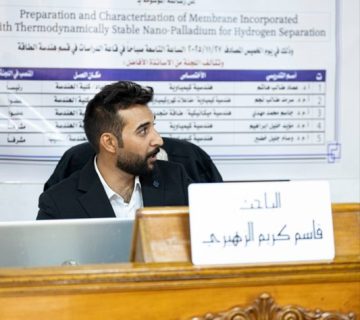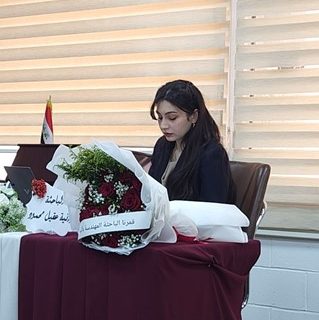Environmental Engineering Department at the College of Engineering, University of Baghdad, held MSc Thesis examination on Thursday 15\2\2024 titled:
“Extraction of Humic Acid as Plant Growth Enhancement During Composting Process”
By the student Daiana Adnan Salih and supervised by Asst. Prof. Dr. Hussain M. Falayeh. The examination committee consisted of Prof. Dr. Shahlaa E. Ebrahim as Chairman, and the membership of Prof. Dr. Khalid K. Hummadi,and Asst. Prof. Dr. Tamara K. Hussain.
After conducting the public discussion and listening to the student’s defense, the dissertation was accepted with excellent degree. It was summarized as follows:
This study aims to recycle organic waste to produce useful fertilizers and to prevent the generation and significantly reduce the emissions of methane, a potent greenhouse gas from organic waste in landfills by composting organic waste, food, and other organics. Compost Improves the soil’s health and structure Through the incorporation of organic substances. Enhances the soil’s capacity to retain essential nutrients and moisture. Enhances the soil’s ability to attract advantageous organisms and reduces reliance on fertilizers and insecticides. Minimizes the likelihood of soil erosion. Iraq produces about 20-25 million tons per year of organic and agricultural waste material, at least according to estimates, Furthermore, only a minute fraction of it is put to use. Most of them are left and burned in the fields or landfills. These processes are not recommended. In addition to its environmental impact. A composting process which is the alternative solution to resource recovery with no side effects, always proved to be the sustainable and environmentally friendly method for elimination of the huge amount of bio-waste. This paper will provide a critical assessment of bioreactor composting and develop an appropriate technology suited to the local environment and economically, technically, environmentally, socially, and environmentally viable methods for treating organic refuse on-site. 60-liter bioreactor used to find the best mixing ratio, proportion, and suitable combination of six mixtures of agricultural waste, sawdust, garbage food waste, sheep, horse, cattle, laying hens manures, and raw activated sludge during composting periods. The physic-chemical and biological changes during this composting period were determined in six different trials. After 35 days of experiments, the final compost was generated, the composting phase was found to have pH 7.42–7.81, electrical conductivity 1.49–3.13 dS/cm, reduced total organic carbon content as a percentage 23–32.09 %, the rise in total nitrogen as a proportion 17.38%– 40.22%, C: N ratio reduction from 20-30:1 to 12.15-16.71:1, the nitrification index NH4+/NO3-ratio decreased by less than 0.5. The optimal distribution of variables was determined after testing several permutations (B1) in this study.
The germination index and humic matter, which consist of a humic material, both humic and fulvic acid, are crucial indicators of compost maturity and stability. It is evident that FA primarily contains aliphatic/carbohydrate compounds, whereas HA is predominantly composed of aliphatic/aromatic structural units. Overall, research using FTIR and 13C NMR spectroscopy proves to be a dependable and appropriate method for evaluating organic matter’s progression, maturity, and stabilization during municipal solid waste composting. The humic acids exhibited a higher prevalence of aromatic structures, while the presence of aliphatic molecules was significantly reduced. This suggests that the compost had achieved a state of maturity and stability.








